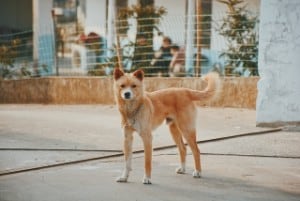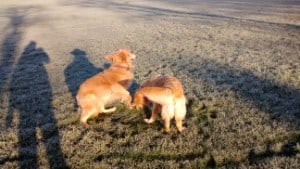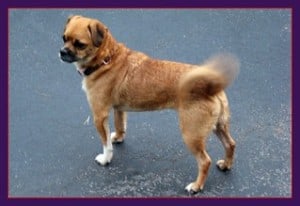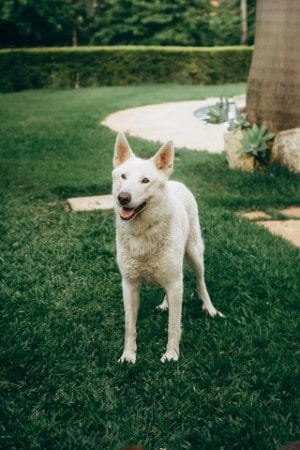
of ways¹
Sometimes it is hard to tell what our dogs are currently going through and what they’re feeling at the moment. But there are ways to tell by looking at their body language. By monitoring their body language, you can get some clues about what they are trying to communicate with you through their tails, posture, barking and facial expression.
It was even said one study that there are 19 confirmed signals that they use to communicate with us. Though nonverbal body languages seem to vary from dog to dog, one way to understand them is by checking their tail. Here are some things you need to know so you could tell if your dog is doing okay or not.
But let’s keep things simple for the moment and answer your original question as a starter.
Why do dogs walk with their tails sideways? 4 Reasons
There seem to be 4 possible reasons why your dog could be walking with their tail sideways
Anal sacs
Just below your dog’s anus are the anal sacs. These contain a scent which is unique to every dog and is used every time your dog poops.
These glands can become infected and impacted causing a lot of pain for a dog, which may result in your dog holding their tail in a different position.
Female dog at height of season

another dog with her tail sideways
These will be a familiar sight for any of you who have breed from your dogs before.
When a bitch is at the height of her “season”, she will be very keen and excited around other dogs.
And part of this is that she walks up to other dogs with her tail in a very unnatural position out to the side.
Tail physically injured
Another reason why your dog’s tail might be held out to the side is because the tail had been injured.
It is being held out to the side because it is less painful to hold it there rather than keeping it in its usual position.
Common reasons for tail injuries include:
- A play session that was a bit too rough
- Your dog was injured in a fight
- A tail has been trapped or shut in a door
A quick physical check should soon help you to see if this is the case. Check to see if there are any cuts or weird angles (which would suggest that a bone within the tail has been fractured) and if there are, book an appointment with your vet.
If your dog doesn’t allow you to get near its tail use this as a prompt to also phone the vet.
Feeling good or bad
As I will explain in much more detail later on, dog’s tail are sophisticated mechanisms for communications and if a dog holds their tail up high and out to the right, it is a sign a confidence.
However, if their tail is positioned much lower and out to the left it is a sign of unease.
I hope that helps you understand some of the reasons that your dog might be walking with their tail out to the side.
In the next section, I begin to explore all the weird and wonderful ways that a dog uses their tail to communicate.
How can dogs communicate with their tail?

for their tail. ²
Before we proceed on learning how they communicate with their tail, we need to recognize first the neutral or natural position of it as it varies by breed. It’s always important to consider the dog’s breed and individual character before interpreting it.
Aside from the dog’s tail position, you need to consider the speed and movement of its tail too. By understanding these, it will give you a clue about their emotional state or what they are trying to inform you as there are times that it easily gets misunderstood. Like for example, if see your dog wagging his tail, doesn’t mean he is happy. Instead, he could be feeling uncomfortable with the situation.
Tail Position
- Neutral position or curled over their backs – if their tail is in their neutral position or for some breeds like chow chows have their tails curled over their back, means they are relaxed or feeling confident.
- Standing with their ears and tail raised – this means they are on alert or agitated and prepared to confront whatever making them feeling uneasy.
- Not wagging his tail – it may mean that your dog doesn’t want to interact. Mostly happens with a stranger.
- Tail held high and still – this indicates that your dog is confident or aggressive. The higher the dog’s tail is, the more aggressive he is and wants to show dominance.
- Tail pointing down – it may mean that your dog is submissive and concerned.
- Tucked between the legs – this means your dog is scared and doesn’t want to get harmed.
- Tail held straight out or horizontally – it means that your dog is curious and feeling neutral with the new information he is getting from the surroundings.
- Tail slightly held high and wagging to the right – This indicates that your dog is happy and feeling pleasant. Based on a recent study, they often wag their tail to the right when they feel positive about something.
- Tail pointing down and wagging to the left – your dog is feeling uneasy or uncomfortable.
- Tail held high and wagging very fast – it may indicate that your dog is aggressive.
Tail wagging speed

- Tail slightly held high and moving fast – it indicates that your dog is feeling excited. The faster the wag, the more excited your dog is. It can be said the same if it moves in a circle.
- Broad strokes – it means they are feeling happier.
- Moving slow – it may mean that your dog is feeling less enthusiastic about what’s happening or worried.
- Smaller strokes – it means that your dog is getting more uptight or feeling anxious.
- Rapid and shaky – this indicates that your dog is afraid or feeling tense.
- Can’t wag – your dog could be suffering from a tail injury.
What does it mean if my dog’s tail is one side?
You will need to visit your veterinarian as soon as possible as his anal sacs need to be expressed or emptied. His anal glands might be full so that is why he is carrying his tail to the side as he might be feeling uncomfortable with it. What you can do is to apply a warm compress on his anal region to provide some relief and take him to your veterinarian.
What does it mean if my dog’s tail is between his legs and shaking?

his legs ⁴
Like I have mentioned before, this could be a sign of fear or anxiety. Dogs usually do this to block the scent coming from their anal glands to prevent other dogs from sensing their presence. However, if your dog is not also eating or drinking, they could be in pain. He could be in pain from injury or illness. It would be best to take your dog to a vet to know what’s causing this and how to treat it.
My dog is holding its tail to one side after grooming. Is that okay?
If he turns his tail to the side, there is a possibility that is he is irritated around his rear limbs. It could be caused by irritation to the glands but could also be some nerve damage or inflammation in his back end. However, never give your dog any medication without your vet’s approval. Take your dog to a vet and let them know his sudden change of behavior.
My dog looks constipated and tucking his tail between his legs, should I be concerned?
Your dog could probably have a hard time to poop due to anal gland impaction or infection. It also suggests that your dog might be suffering from a possible back injury or neck pain.
My old dog tucks his tail between his legs. What could that mean?
It is possible that he was maybe not interested in socializing with other dogs and preventing them from sensing his presence. As he grows old, he is getting more uninterested with things and doesn’t have the energy to socialize with younger dogs.
However, it could also be a sign that your dog is experiencing health problems due to his age. Dogs don’t usually complain about discomfort unless the pain they’re experiencing is severe.
My dog’s tail is between his legs while eating. Does that mean they don’t like the food?
The simple answer is no. It is a sign that your dog is concentrating and not a sign of distress or discomfort. Dogs often do this if they are doing something that they find enjoyable and when they are focusing hard on something. So, if your dog is doing this while eating then take it as a compliment instead. However, some dogs do feel nervous or stressed when they are eating with other dogs or being around with strangers. Try to let him eat alone or away from other dogs to see if that’s what makes him nervous or stressed.
My neighbor dog’s tail appears to be twitching whenever I am around, should I be afraid?
Your neighbor’s dog might be familiar with you but might not comfortably seeing you around. If his tail is pointing upward and twitching, he is trying to tell you that you are on his territory. So, it is best to back off as that dog might get aggressive and attack you.
Learning this could save you and your dog from a lot of trouble and lets you enjoy walking your dog without an incident. Sometimes, dogs don’t like other dogs for some reason. They might not be comfortable around strangers or had a bad experience with another dog of the same breed. So you better stay away if you see a dog showing off his dominance.
Is my dog sick if his tail is between his legs and he’s panting?
Seeing your dog panting without a good reason is not a good sign. It means that your dog is feeling sick or unwell. Your dog may be suffering from heatstroke or respiratory disorders. If you can’t find any good reason why your dog is panting, immediately take your dog to a vet.
What does it mean if my dog’s tail is hanging down for days?
If your dog’s tail is hanging flaccidly for days, it means they are suffering from Limber tail syndrome or Acute Caudal Myopathy. Limber tail is a disorder of muscles that mostly affects large breed dogs causing the dog’s tail to become flaccid due to a muscle sprain. However, it also can be caused by other things like overexertion, prolonged crate confinement, exposure to cold weather, and abnormal exercise.
Keep in mind that these are all just guidelines.
Learning your dog’s body language is a must and observing your dog’s tail movement is just one way to understand what they are trying to tell you. However, tail wags can have different meanings depending on the situation. Look at every signal and clues that your dog is giving to you from the tail to his expression.
Being able to understand their body language will help you prevent problems before they occur and understand their emotional state. It could also save you from trouble when meeting with new people and their pets. If you can identify certain tail behaviors, you can act appropriately before the dog starts barking or attack you.
Photo Credits
² Photo by Tadeusz Lakota on Unsplash
³ Photo by Bill McChesney on Flickr
⁴ Photo by Helena Lopes on Unsplash
⁵
⁶
⁷
⁸
⁹





